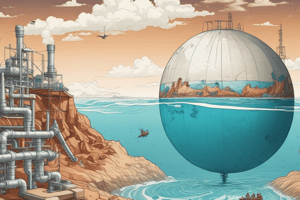Podcast
Questions and Answers
Which factor contributes to the lower salinity in coastal areas compared to the open ocean?
Which factor contributes to the lower salinity in coastal areas compared to the open ocean?
- Higher evaporation
- Higher fresh water runoff (correct)
- Higher sea ice concentration
- Higher precipitation
What is the salinity of the Dead Sea?
What is the salinity of the Dead Sea?
- 35 parts per million
- 330 parts per thousand (correct)
- 15 parts per hundred
- 30 parts per thousand
What are the two main factors that affect salinity?
What are the two main factors that affect salinity?
- Evaporation and sea ice
- Fresh water runoff and precipitation
- Fresh water runoff and sea ice
- Evaporation and precipitation (correct)
Which of the following is the largest reservoir of water on the planet?
Which of the following is the largest reservoir of water on the planet?
Which of the following has the highest concentration of ions in seawater?
Which of the following has the highest concentration of ions in seawater?
What causes an increase in salinity in mid-latitudes?
What causes an increase in salinity in mid-latitudes?
Which factor leads to decreasing salinity over the equator?
Which factor leads to decreasing salinity over the equator?
What is the main cause of the massive jungles in the Amazon River basin?
What is the main cause of the massive jungles in the Amazon River basin?
Which process is responsible for the high concentration of sodium and chloride in the ocean?
Which process is responsible for the high concentration of sodium and chloride in the ocean?
Which reservoir has the largest exchange of water with the atmosphere?
Which reservoir has the largest exchange of water with the atmosphere?
Which method of desalination is considered simple and low-cost, but not very efficient?
Which method of desalination is considered simple and low-cost, but not very efficient?
What is the main reason for the adoption of desalination methods to address the decreasing water supply?
What is the main reason for the adoption of desalination methods to address the decreasing water supply?
Which factor has a larger impact on the density of ocean water?
Which factor has a larger impact on the density of ocean water?
What is the rapid change in temperature with depth called?
What is the rapid change in temperature with depth called?
Which factor influences the salinity distribution in ocean water?
Which factor influences the salinity distribution in ocean water?
What is the layering of ocean water according to density called?
What is the layering of ocean water according to density called?
Which factor is not as significant as salinity and temperature in influencing density?
Which factor is not as significant as salinity and temperature in influencing density?
In which regions is there no thermocline due to cold temperatures?
In which regions is there no thermocline due to cold temperatures?
What is the rapid change in density with depth called?
What is the rapid change in density with depth called?
Which layer in the ocean supports life by allowing light to penetrate?
Which layer in the ocean supports life by allowing light to penetrate?
What causes the low pH layer in the ocean?
What causes the low pH layer in the ocean?
What helps maintain a relatively stable pH in the ocean?
What helps maintain a relatively stable pH in the ocean?
What are important aspects of the ocean buffering system?
What are important aspects of the ocean buffering system?
What happens to the concentration of dissolved carbon dioxide in the ocean?
What happens to the concentration of dissolved carbon dioxide in the ocean?
What role do marine organisms play in regulating dissolved carbon dioxide levels?
What role do marine organisms play in regulating dissolved carbon dioxide levels?
What happens to the oxygen concentration below the surface of the ocean?
What happens to the oxygen concentration below the surface of the ocean?
Flashcards are hidden until you start studying
Study Notes
Water Crisis and Desalination Methods
- The demand for fresh water is increasing while the water supply is decreasing, leading to water shortages.
- Water conservation became important during a drought period, but after reservoirs were recharged, the issue was not prioritized.
- Similar to fossil fuels, the price of water needs to become cost prohibitive for alternative technologies to be adopted.
- Desalination plants, which remove salt from water, are being built in regions with salty water, and may soon appear in California.
- Solar distillation is a simple and low-cost method of desalination, but it is not very efficient.
- Heating water can speed up the process of distillation, but it still has limitations.
- Reverse osmosis is a more effective method of desalination, but it is expensive and requires specialized membranes.
- Freeze separation is another method, where seawater freezes and leaves behind salt, resulting in relatively fresh water.
- One proposed solution for water issues in California was to transport icebergs from Alaska to provide fresh water.
- Seawater is alkaline, while fresh water is slightly acidic due to the dissolution of minerals.
- Salinity is expressed as parts per thousand, which is equivalent to a fraction with an extra zero.
- The water crisis is a pressing issue that requires the adoption of desalination methods to address the decreasing water supply.
Ocean pH and the Carbonate Buffering System
- The thermocline is the layer in the ocean where light penetrates and supports life.
- The low pH layer in the ocean is caused by marine and animal respiration, which releases carbon dioxide.
- The ocean has a buffering system that helps maintain a relatively stable pH.
- Precipitation and the presence of calcium carbonate are important aspects of the buffering system.
- The concentration of dissolved carbon dioxide in the ocean steadily increases until the bottom of the thermocline.
- Marine organisms play a role in keeping the dissolved carbon dioxide relatively low by pulling out calcium carbonate from seawater.
- Oxygen concentration in the ocean is higher at high latitudes due to photosynthesis by marine organisms.
- Oxygen concentration decreases quickly below the surface and then starts to increase with depth.
- The ocean acts as a carbon sink, absorbing more than a quarter of the excess carbon dioxide from burning fossil fuels.
- The increase in carbon dioxide can disrupt the base of the food chain and have a cascading effect on the ocean ecosystem.
- Rising temperatures decrease the solubility of carbon dioxide and oxygen in the ocean, leading to potential oxygen depletion.
- The dissolution of marine organisms' shells and the decrease in oxygen levels can have detrimental effects on ocean life.
Studying That Suits You
Use AI to generate personalized quizzes and flashcards to suit your learning preferences.




